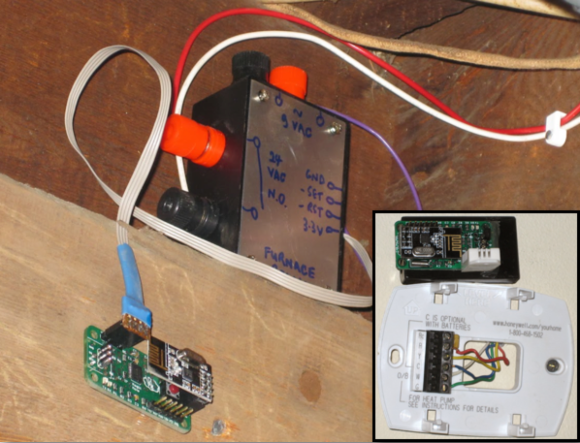
The thermostat in [Tom’s] 100-year-old house is two floors up from where the furnace is located, so a broken wire in the wall was just the catalyst needed to design a wireless thermostat.
The system is based on a customized PCB [Tom] designed called the Magic Mote. The board contains an MSP430 microcontroller, a low power NRF24l01+ wireless transceiver, and various sensor interfaces. The wireless thermostat project uses two of these boards; one monitors the temperature on the second floor and the other controls the furnace in the basement.
The temperature sensing is done using a DHT22/AM2303 temperature and humidity sensor, which is a convenient choice, since the part is calibrated and handles the analog digital conversion; you just need one digital pin to retrieve the temp/humidity data. To control the furnace, [Tom] used the local 24VAC and a latching relay to drive the heater signal. The 24VAC also powers the board, so a door-bell transformer steps the voltage down to something more usable; about 11VAC or so, which is then rectified, filtered, and regulated down to what the control electronics like to see (3.3V/5V).
This project is actually still in the early stages of what [Tom] has planned; a network of sensors and appliances with a beagle bone base station. We can’t wait to see what’s next for this project; maybe we’ll even see some voice control, like in this epic Siri controlled home automation project.
[via Dangerous Prototypes]















This is a solid hack. Problem encountered, problem solved. Case closed, why can’t you guys just leave it at that? Almost every post has some remark about how you’d rather have seen some piece accomplished or some crazy next step… And they rarely add value.
really ? :))
Clever, However living in a hundred year old home myself, I just rewired the thermostat to a main floor location, In fact the IDEAL location for a thermostat is away from any outside walls and close to a return air grill so it can accurately sense the temperature going into the furnace. Also honeywell makes a new thermostat series called redlink. you can actually get an ap for it on your smart phone, Of course we get away from the hack aspect this way, but it does get the job done.
At minus F tonight I hope it works perfectly.
so the distance is about what 20′?
I noticed he didn’t place any of it inside a project box so im wondering whats the range on the nRF24L01+ beyond sufficient?
any one have experience with these in indoor settings?
Correct, the distance is about 20′, mostly vertical. The signals were weaker away from the stairwell. Internal walls and interference from the wireless internet router seem to be factors in the range. I plan to install a tree-like network of sensors so that the signals cascade. This should reduce the distance between adjacent nodes.
One thing jumped up at me immediately: Doesn’t the MSP430 µC family have an internal temperature sensor? Or have I been fooled by the ones available for LaunchPad? Anyhow, I’m planning to to something similar (replacement wireless temp. sensor for cheapie weather station), so this’ll be useful :)
You are right! I doubt it is particularly accurate, and may be vulnerable to self-heating. But this would be a good thing to test and log.
I’ve got two MSP430G2253s side by side here right now running the same code. One reads 14C, the other 20C. I suppose I could come up with a calibration scheme and see if they’re stable over time and battery range… maybe some day. I do know that I can heat them up and cool them down a few degrees by turning on and off low power mode, so yes, they are vulnerable to self-heating.
Amazing coincidence: I’m also playing with the NRF24l01+ radios on MSP430s and downloaded Spirillis’ msprf24 library just yesterday an hour or two before this was posted.
nice hack, for completeness I’d mention the Honeywell Redlink system for a wireless thermostat system.
Nicely done.
For any Europeans after a commercial system, I can thoroughly recommend Tado – coincidentally built using the MSP430 and Stellaris.
Nice hack! I like the fact that he diagrammed and labeled everything on the outside of the box so that there are no gotcha’s a year from now when he’s trying to remember what he did…
Pretty great project! I am currently working on a custom thermostat of my own which will be powered by an Electric Imp. As a software engineer, I’m currently struggling with how to power the system from the 24VAC and this build gives me some good ideas. Thanks!
I’ve been monitoring my commercial off-the-shelf thermostat and I found that half-a-degree tolerance is far too tight of a control range for my particular circumstance. I had to change the swing value on the thermostat to be 1 degree Fahrenheit in swing to prevent the furnace from cycling on and off too frequently. What you’re aiming for is to prevent the unit from coming on more than 3 times per hour – the goal being to reduce wear on the furnace and make it last longer.
I’d recommend getting some kind of receiver on a computer so you can see what’s actually happening throughout the day. In my case (no, there’s no writeup yet as it’s still in development), I also discovered whether or not I needed to make adjustments to the furnace’s output so that it would heat the house more efficiently. I may, in fact, see about reducing the blower’s speed to determine if it would save more energy.
For that prior week (every other day), I’ve completed the baking soda
scrub in the shower, then washed my experience with my regular face wash.